Presidents: William McKinley
Birthplace: Niles, Ohio
Visited in 2013.
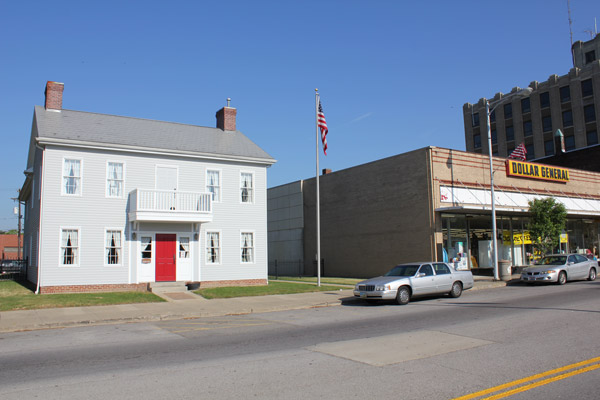
The recreation of McKinley's birthplace, and also a Dollar General.
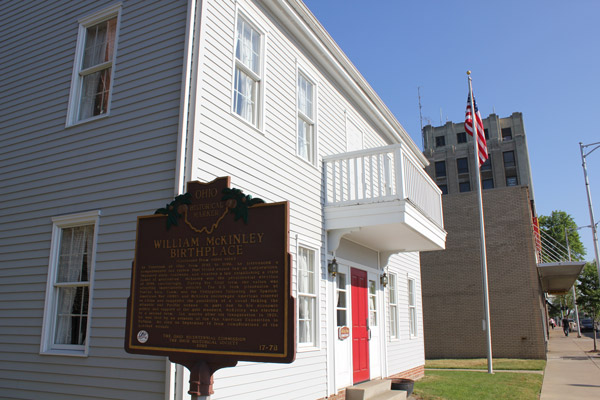
Another view of the replica birthplace.
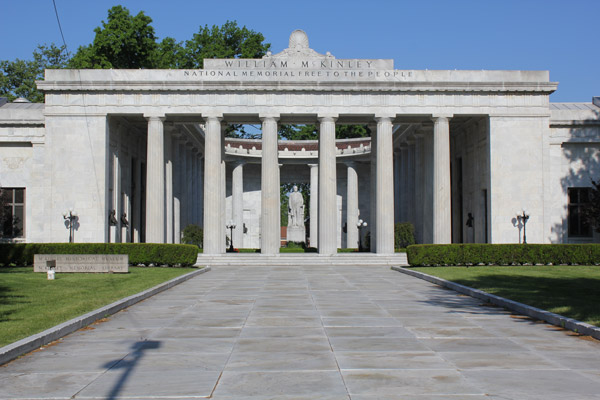
Approaching the Memorial Library, a few blocks from the birthplace.
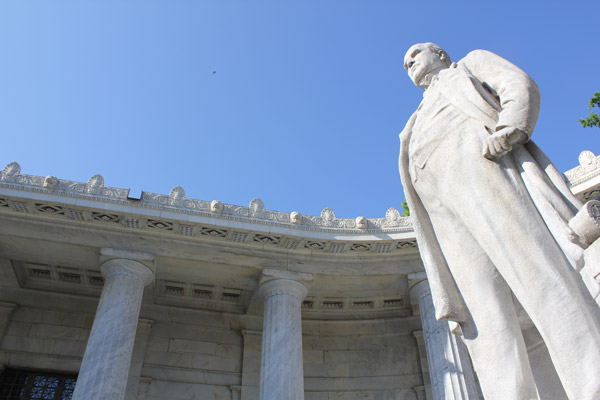
The McKinley statue at the Memorial Library.
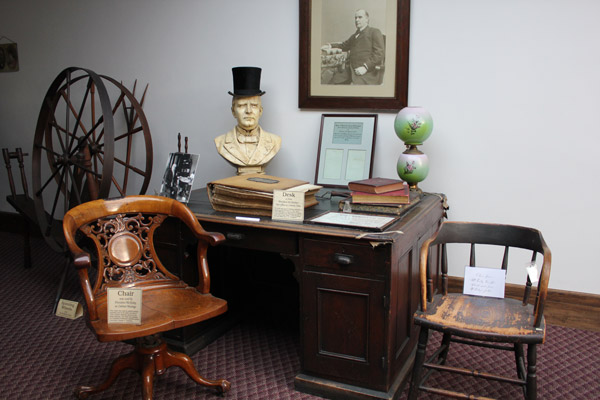
McKinley relics at the museum attached to the memorial library.
Objectively speaking, the end of William McKinley's life was more interesting than the beginning. A mentally unstable anarchist took him out of this world, while uptight Methodists brought him into it.
Still, you gotta start somewhere. McKinley was born in 1843 in Niles, Ohio, north of Youngstown. He was the seventh of nine Irish/Scottish halfbreeds -- a mix that cemented his fighting spirit and hatred of underwear. His family had come to Ohio from Pennsylvania, and despite that horrible decision they seemed to prosper in the iron-working business. The town was pretty new, and the McKinleys owned property pretty close to the Mahoning River.
Even back then, parents moved to find better school districts. By 1852, the family had departed to Poland, south of Youngstown, so McKinley could go to some hoity-toity academy there. Nothing terribly interesting has happened in Niles since then. The iron-working industry has moved elsewhere, and it has been replaced by the dilapidated-motel-not-too-far-off-Interstate-80 industry. My room in the Economy Inn had a very nice sign reinforcing that anyone using the room for more than 15 minutes would have to pay for a full night, and that the "no drugs in the room" policy was fairly strict. People clearly respected the sign, because the probable meth addicts seemed to be hanging out in the parking lot. The next morning at the breakfast buffet, someone stole two gallons of orange juice.
But let's not smear the whole city. The downtown area of Niles is cute enough. Like a lot of small towns in the Midwest these days, it's quaintly unspoiled by economic development. I drove in, found a parking space and went in search of the McKinley Birthplace on Main Street. You can't miss it. It's right next to the Dollar General.
It might break your heart to know that, even on a Friday morning, it was closed. I was alright with it. The home is actually a reconstruction. After the McKinleys left town, the original building became a general store, was split into two pieces, got moved around and eventually burned to the ground in the 1930s. The eight-room, two-story replica is on the same site as the original house, and it's an architectural match. But there isn't any significant McKinley swag inside. The decorations are just a best guess, and if you've seen the outside you've seen the best part.
So the real show is down the street at the McKinley Memorial Library. You can't miss it. It's on the other side of the Dollar General, and it's the only thing in town that looks like a Greek temple. About a decade after McKinley was assassinated, a wealthy industrialist from Niles thought it might be nice to honor the city's most famous son. He got the fundraising together, and in 1917 the finished structure was dedicated -- as its inscription says, "free to the people."
Even at that price point, there wasn't a big line at the door in 2013. But it's really a very cool structure. There's a colonnade facing the street, and when you walk through it you're in a courtyard with a nice-looking, dignified McKinley statue in the center. (Dignified isn't easy to pull off with McKinley, who was sort of on the beefy side in his later years.) He is surrounded by a semi-circular wing of busts depicting some of his contemporaries and friends -- Bill Taft, Mark Hanna, Teddy Roosevelt and Andrew Carnegie among them. One side of the courtyard has the entrance to a public library, and if you go in and stand awkwardly by the entrance for a few minutes, they'll figure out that you want to go to the museum on the other side of the courtyard.
"Museum" actually might be too generous of a description, in this case. It's a meeting hall, and the second floor has a balcony with a few glass cases and historic displays. The have a few of McKinley's personal effects on display, and campaign buttons, and photos from McKinley's time. They do have a shot from the dedication of the memorial in 1917, and the mass of humanity that showed up for that event was truly impressive. Memories move on pretty quickly in America, though.
I got to enjoy all this by myself. Once a library staffer unlocked the door to let me in, he didn't bother with turning on lights or giving any tours. He pointed to the steps leading to the balcony and wandered off somewhere else. I was alone in the building, with no security cameras clearly visible, and some of the artifacts were only behind velvet ropes. The point is, if I really wanted to, I could have stolen William McKinley's top hat. I didn't, because I have an abiding respect for history and I look bad in hats. But for all you enterprising meth heads on the I-80 corridor with connections to the historical artifact black market -- heads up.
For a modest guy from Niles, McKinley did alright. He volunteered for the Civil War, attended law school in New York and then moved to Canton at his sister's behest. He ran for Congress at the age of 33 and saw seven glorious terms in the House before becoming governor of Ohio. Though anticipating retirement in 1896, he answered his party's call as the GOP presidential nominee. Under guidance from McKinley's firm hand, we beat back the subhuman mongrels of the Spanish empire, driving the white devils from many of their strongholds and guaranteeing the future of the Florida Marlins farm system, and a democratic Cuba, in the process.
Most of this, the public has long since forgotten. McKinley was a little bit of a puppet for Mark Hanna and the machine politicians of Ohio, but he was still a key figure as America transitioned into an imperial and industrial superpower. The problem was, Theodore Roosevelt followed on his heels and outshone McKinley in just about every way. For example, when Roosevelt got shot by an insane person in 1912, he manned up and didn't die.
But I swear to you, McKinley was kind of a big deal.
Home: First Ladies National Historic Site, Canton, Ohio
Visited in 2013.
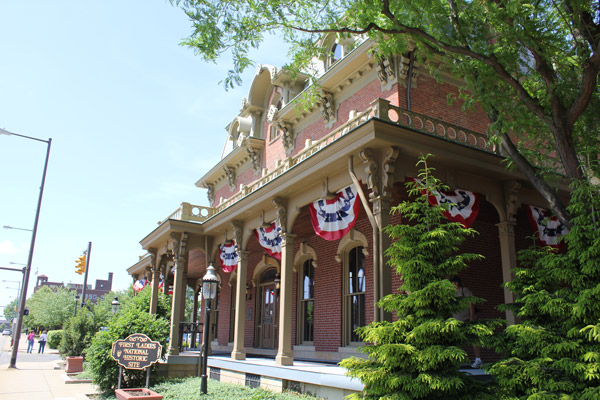
McKinley's only surviving home, now dedicated to the First Ladies.
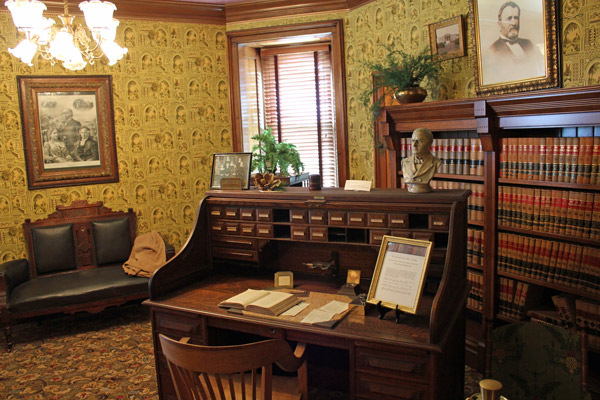
The home offices of a successful Canton lawyer.
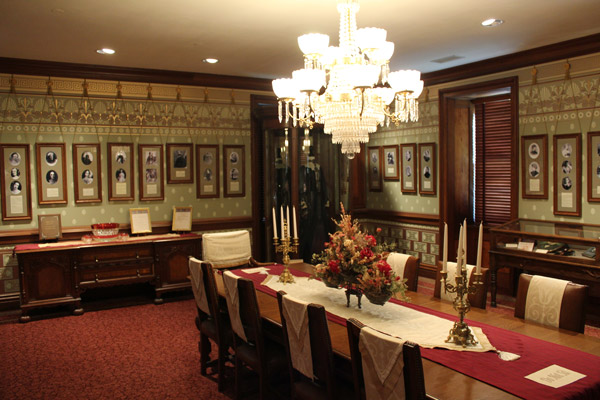
One of the meeting spaces at the First Ladies National Historic Site.
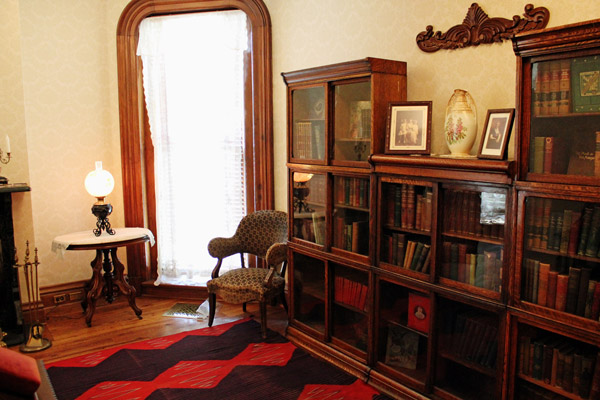
A Saxton / McKinley parlor.
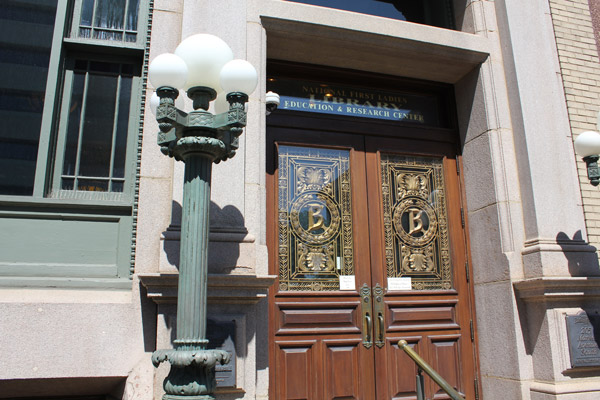
The converted bank that's now park HQ for the FLNHS.
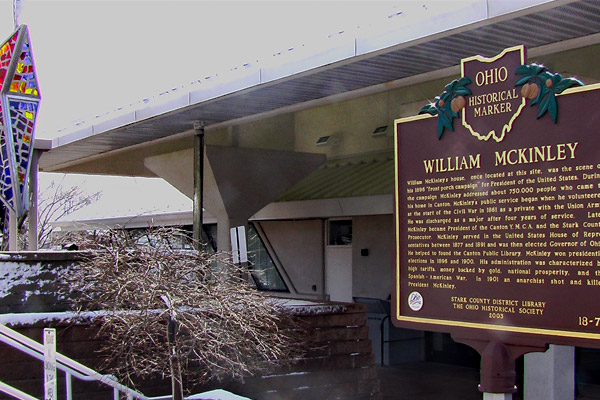
The marker at McKinley's (now demolished) Canton home.
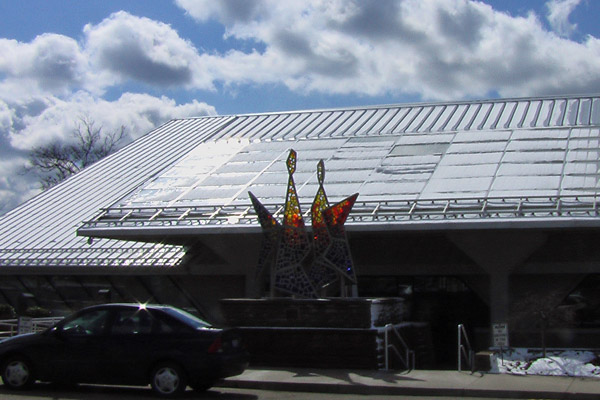
The library standing on the site of McKinley's demolished Canton home.
A cursory search on the interwebs will tell you that there is no McKinley home to visit. He famously conducted a winning "front porch" campaign in the city -- but that porch and the building it rode in on are long gone. The lumber was converted (really) into park shelters and benches by the city of Canton in the 1930s. The site of the home is now a library with a historical marker (and a giant sun-catcher) out front. I saw it with my own eyes in 2008.
After seeing that library, I hopped in my car and left Canton. Then, a few weeks later, I did a less-cursory search on the interwebs, which revealed unto me the First Ladies National Historic Site.
If you've never heard of the First Ladies National Historic Site, it's because you are a normal American. It's one of the least-visited sites in the National Park system. The longtime congressman for Canton, Ralph Regula, made it one of his pet projects to get the property into the park system, and he managed to pull it off despite a complete lack of demand. Oddly enough, the people who come to Canton for the Pro Football Hall of Fame don't also go in for informational displays about china patterns from the 19th century. Those dicks.
The site consists of two properties: a converted old bank which serves as the visitors center, and the beautifully restored family home of Ida Saxton McKinley. They might draw a few more history nerds if they actively advertised it for what it is: The only standing home of William McKinley. THAT's what the football fans want to see.
To accommodate the complete lack of interest, tours of the Saxton home are sporadic. When I rolled into downtown Canton, I had 90 minutes to kill before the next one. I had lunch at Benders, the oldest restaurant in town (McKinley died the year before it opened). I cruised by the Stark County courthouse, where McKinley used to work as a county prosecutor. Then it was back to the bank to see whatever displays they had to offer. It's not bad, but it has the same problem as any historic site dedicated to a marginalized group of people:
Site: Hey, these women are really important, even though they've been ignored!
Me: Great! What can you show me?
Site: We've got these dresses!
Even so, the tour of the Saxton home was fantastic, and it didn't hurt that I was the only one on it. The building was in Ida's family for a long time; she grew up there and lived there while working as a teller at a bank her father ran. She met McKinley at a picnic and they were married a few years later. They had their own place (with the famous front porch), but once Bill started traveling to D.C. for his political career, they usually rented that home out. When they were in Canton, they stayed at the Saxton home with Ida's sister and her family. Bill had a law office in one of the upstairs rooms, and they also had some great space for entertaining; at one point during a Civil War reunion weekend, McKinley, Rutherford Hayes and James Garfield were all staying in the home at the same time. The interiors are all restored to their upper-middle-class glory.
Ida's story is compelling. She and Bill had two girls, both of whom died very young; they had lots of nieces and nephew in their life, but apparently Ida didn't handle the loss of her own kids too well. She spent countless hours knitting booties and bedroom slippers. She also wasn't the most robust person in the world -- she had a 20-inch waist, and later in life she started suffering debilitating seizures and migraines. At formal functions, McKinley always sat next to her (which wasn't normal custom for the time), and when he heard a telltale hissing sound from his wife he would unfold a napkin and cover her face until the attack passed. Her doctors didn't let her attend her husband's funeral, for fear that it would have catastrophic effects on her health. Contemporaries generally regarded her as weird, and she died seven years after her husband.
Popular or not, it's a wonderful thing that the house still exists. After the Saxtons were gone, the property changed hands a few times. Subsequent owners put a brick shell on the outside, extending up to the sidewalk. Storefronts were put in, and they were suited to the general downturn of Canton in the middle of the 20th century. They have pictures from the era where you can clearly see that portions of the home were divided into a liquor store and a bar. According to the guide, more than one visitor has remarked that they remember the bar, and that it served great hotdogs.
And there's the answer to their problems. Great hotdogs are as much of a national treasure as our presidents and first ladies, and any site combining those things would have to beat off guests with a stick. The First Ladies National Historic Hot Dog Stand and Historic Site might be able to compete in this economy. You can have that idea for free, government. You're welcome.
Assassination Site: Buffalo, N.Y.
Visited in 2008.
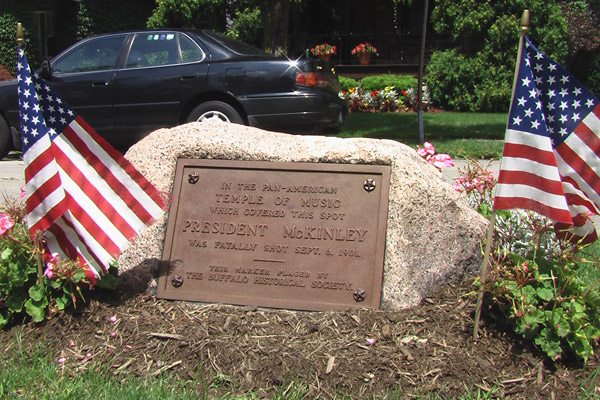
The world's most significant urban median strip.
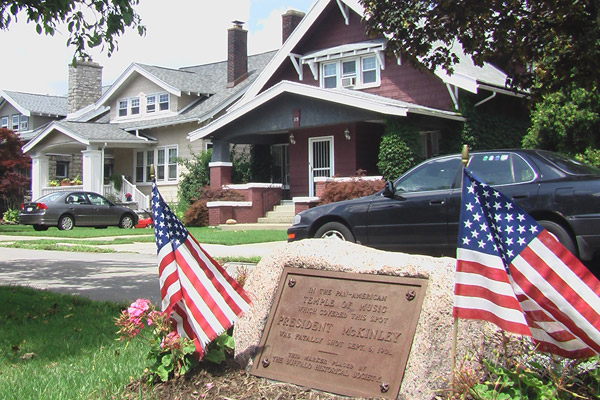
A small plaque for a HUGE turning point in American history.
Of the many fine people who have made significant contributions to American History, Leon Czolgosz probably has the name that's hardest to spell. But did he let it stop him? NO! He had his one shining moment on Sept. 6, 1901.
Unfortunately, that moment involved murdering the president. Czolgosz, a dedicated loon, was a deadbeat impressed by the anarchist movement of the late 19th century. Not understanding how anarchy truly works, he wanted to climb the anarchist ranks and possibly impress some hot lady anarchists in the process. (All this is expertly recounted in "The President and the Assassin" by Scott Miller, if you want the full story.) After tracking McKinley's movements for months, Czolgosz thought there would be an opportunity in Buffalo, where McKinley would be attending the Pan-American Exposition.
As dumb as he was, Czolgosz was right. McKinley opted to greet fellow citizens at a reception in the fairgrounds' "Temple of Music." Security was present, but not in the modern sense -- as people lined up to shake McKinley's hand, the "screening" mostly consisted of guards nervously eyeballing the line. Czolgosz queued up and waited his turn, all the while holding a gun in his pocket. For extra secrecy, he wrapped that hand in a handkerchief. When he got to the front of the line, he shot McKinley twice. By the time the guards took him down, it was too late. The wounds were fatal, and McKinley died at a nearby home about a week later. (That building is gone, and only a sign remains.)
The fairgrounds weren't meant to be permanent, and before long the Temple of Music was torn down. Today, the approximate scene of the crime is in a pretty nice looking neighborhood in Buffalo. There's a historical marker on a median strip. When I stopped by, a middle-aged guy was mowing his lawn with his shirt off 15 feet away. As I was leaving, I saw in the rear-view mirror that he was mowing the median around the rock. I can't decide if this is patriotic or not.
McKinley Memorial, Canton, Ohio
Visited in 2008 and 2013.
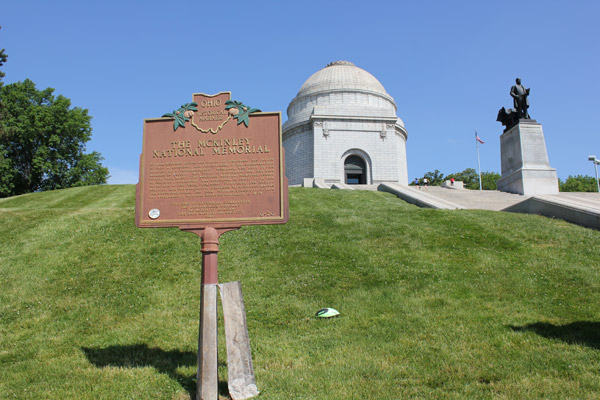
One of the most massive presidential graves.
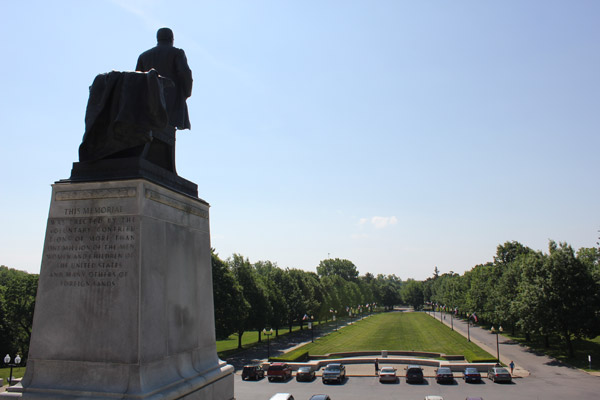
Looking out from halfway up the steps.
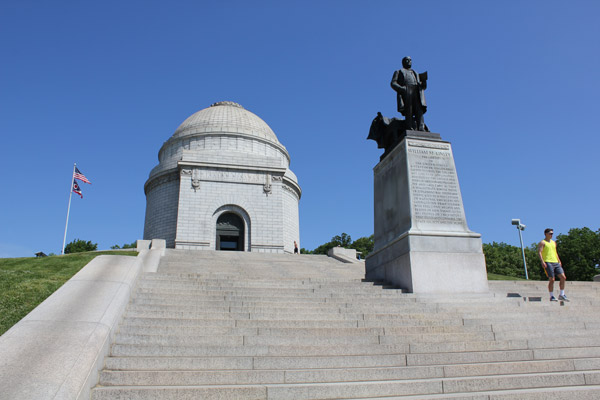
A closer view of the mausoleum.
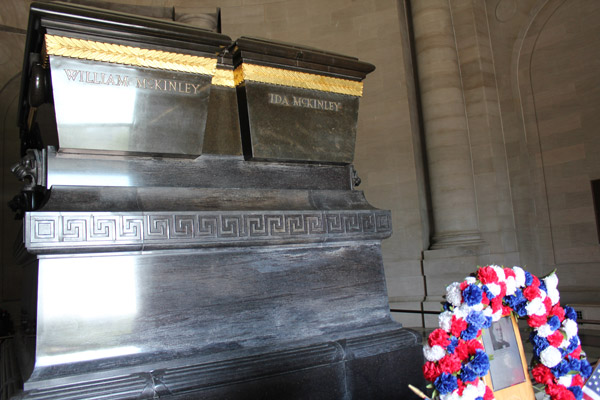
The inside of the memorial, and the elevated resting place of Bill and his wife.
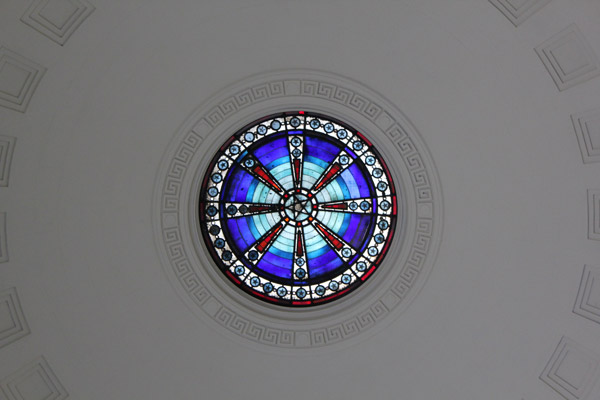
Looking straight up at the interior of the memorial's dome.
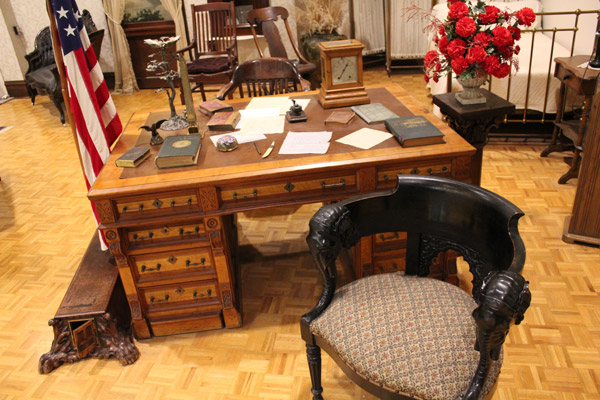
One of McKinley's desks, on display in the museum next to the memorials.
Some people doubt William McKinley's greatness, but the proof is in Canton, Ohio. McKinley is resting there, in a 97-foot-tall mausoleum that would make most dead European monarchs blush if they still had circulating blood.
There's an entire park built around McKinely's resting place, which sits atop a hill facing a long bowling green and downtown Canton. There's a majestic staircase leading from the green up to the tomb, and the body-conscious metrosexuals of Canton honor McKinley's memory by jogging up and down those steps, shirtless, on their lunch hour. It's a moving sight, even moreso than the non-stop Zumba vigil in front of Washington's tomb at Mount Vernon.
The first time I visited the McKinley tomb it was in the off-season, when the central chamber was closed. And while I was fine skipping the interior of the replica birthplace in Niles, you can't visit a mausoleum and miss out on the sarcophagus. It's the best part! So I was thrilled to see it on a return visit in 2013. McKinley and his wife, Ida, are encased in big blocks of dark-green granite on a black granite pedestal. The rest of the interior has a suitable number of carved lions and eagles and other things that are symbolic of what a kick-ass nation McKinley led. They really did put a lot of thought into the whole arrangement (completed in 1907, by the way), as evidenced by this tidbit from a very informational plaque:
"The memorial design, including the sunken lawn and the roadways, suggests a cross hilted sword with the mausoleum at the junction of the blade, guard and hilt. It symbolizes the cross of the martyr and the sword of the president in time of war."
Take that, you Spanish bastards.
At the foot of the mausoleum hill and just off to the side is a fine little museum run by the Stark County Historical Society; it claims to have the "largest collection of McKinleyana" in the world. That amounts to one room with some old furniture, a few cases of campaign buttons and dolls of McKinley and his wife, Ida. The dolls, by the way, are animatronic and on a motion sensor, If you don't know that they're animatronic, and you're the only person visiting, and you have your back turned when they suddenly start talking, you will probably almost crap your pants. This happened on my first visit in 2008. Someone may have actually crapped their pants or had a heart attack between then and 2013, because on my return visit they did not talk at all. Sigh.
